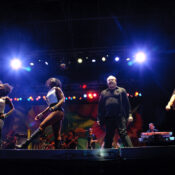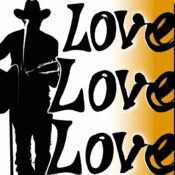Thousands of fans lined the observation deck at the newly christened John F. Kennedy International Airport, screaming and waving banners as the four mop-top Britons descended the steps from Pan Am Flight 101. They were, of course The Beatles, arriving in New York for the first time on February 7, 1964. It was like nothing America had ever seen before, and their arrival would change the American music scene forever.
The group made their American debut on The Ed Sullivan Show just two days after arriving in New York and, with some 73 million viewers tuning in, the legendary band kicked off what became known as the British Invasion, a cultural influx of British rock and pop music that would dominate the 1960s.
The Beatles perform their hit song, “I Want to Hold Your Hand” on the Ed Sullivan Show. (Uploaded to YouTube by The Beatles)
There are a number of theories on why The Beatles and other British acts became so popular in the States. The group represented a welcome distraction from the unrest plaguing the nation, with the JFK assassination occurring just 11 weeks prior. Rolling Stone magazine suggested that The Beatles represented a “youthful idealism” popularized during the Kennedy presidency. Or perhaps the death of Buddy Holly, alongside Elvis’s military service and subsequent turn to filmmaking, created a vacuum that paved the way for The Beatles and other British Invasion acts.
Whatever the reason, the youth of the 1960s zealously embraced The Beatles, much to the dismay of the older generation. Indeed, many critics panned the group’s performance on The Ed Sullivan Show: the New York Times dismissed the Fab Four as nothing more than “a fad,” while Newsweek reported that the group was “visually … a nightmare” and “musically … a near disaster.”
By 1964, Beatlemania was sweeping across America, with the group placing an unprecedented 29 songs on Billboard’s Hot 100 chart. Yet, The Beatles were hardly the only British artist dominating the U.S. charts. They were soon followed by a wave of British contenders, all fighting for the number one spot.
The next British act to break the Hot 100 was Dusty Springfield with “I Only Want to Be With You,” entering the chart at number 77 in January of 1964, just two weeks after The Beatles’ American debut. Springfield was soon followed by the Dave Clark Five, whose single “Glad All Over” debuted at 77 just one month later. By April 17, British acts accounted for five of the Hot 100’s Top Ten records, and the British Invasion was in full swing.
Dusty Springfield performs her 1963 American hit “I Only Want to Be with You.” (Uploaded to YouTube by Classic Hits Studio)
This new music from across the pond encompassed a variety of styles. While The Beatles’ early music popularized the more polished pop acts of bands such as the Hollies (“Bus Stop”) and the Zombies (“She’s Not There”), a harder-driving rhythm and blues scene was emerging in London with the Yardbirds (“For Your Love”) and Rolling Stones (“Get Off of My Cloud”). These acts were soon followed by a plethora of influential artists, from The Who and The Kinks to The Animals, to name a few.
Behind The Beatles, the Rolling Stones are perhaps one of the most enduring bands to come out of the British Invasion. While the group landed several songs in Billboard’s Top 100 in 1964, they didn’t hit it big until the 1965 release of “(I Can’t Get No) Satisfaction,” which spent four weeks at number 1.
The gritty, rhythmically driven music of the Stones represented an abrupt departure from the sunnier pop sounds of The Beatles that defined the early stages of the British Invasion. In fact, manager Andrew Loog Oldham purposely fashioned the band as the antithesis of the Fab Four. As professor of music history David Szatmary writes in his book Rockin’ in Time, he wanted to make the Stones “a raunchy, gamy, unpredictable bunch of undesirables” to contrast with The Beatles’ upbeat and family friendly image.
The Rolling Stones perform “(I Can’t Get No) Satisfaction” live in Ireland. (Uploaded to YouTube by ABKOVEVO)
As the 1960s wore on, the hard-edged rhythm and style of rock’ n’ roll grew increasingly popular with American youth, resonating with the counterculture movement that was spreading across the nation in the wake of recent political unrest. Indeed, as proponents of the movement rejected the conformity and consumerism of Western lifestyle, the music of the times grew increasingly experimental, a shift that The Beatles themselves embodied by their retreat to the studio and subsequent avant-garde music.
By 1966, the band’s hectic touring schedule and screaming entourage of fans prompted them to retire from touring, playing their last show at San Francisco’s Candlestick Park on August 29 of that year. Freed from the constraints of having to give live performances, the band explored groundbreaking studio methods for their next few albums, recording in stereo and incorporating tape loops and feedback into their music. For the psychedelic number Tomorrow Never Knows, the band even experimented with revolving speakers and backward guitar solos. With the release of their albums Revolver and Sgt. Pepper’s Lonely Hearts Club Band, The Beatles revolutionized the modern rock album, inspiring the music of genre-defining artists such as Pink Floyd and The Doors for decades to come.
While the end of the British Invasion in America is largely contested, the domination of U.S. charts by British acts began dying down in 1966. Inspired by The Beatles and other British Invasion bands, American artists like The Beach Boys and the Doors began innovating their own sound. In April of that year, there were no British artists in the top ten for the first time in 27 months.
1970 may have seen the breakup of The Beatles, but the band left behind an enduring legacy that forever changed the face of popular music. The impact of the Fab Four can still be felt today, with modern groups like Nirvana and Panic! at the Disco citing their influence. By leading the British Invasion and popularizing a new style of rock, The Beatles paved the way for countless artists who followed in their footsteps. They did, in fact, start a “revolution.”
Become a Saturday Evening Post member and enjoy unlimited access. Subscribe now




Comments
This piece was very interesting! I greatly enjoyed the connections you drew between the Fab Four and other acts past and present, and the correlations with the American musical culture of the time.